Zhengtao Zhang
Survey of Vision-Language-Action Models for Embodied Manipulation
Aug 21, 2025Abstract:Embodied intelligence systems, which enhance agent capabilities through continuous environment interactions, have garnered significant attention from both academia and industry. Vision-Language-Action models, inspired by advancements in large foundation models, serve as universal robotic control frameworks that substantially improve agent-environment interaction capabilities in embodied intelligence systems. This expansion has broadened application scenarios for embodied AI robots. This survey comprehensively reviews VLA models for embodied manipulation. Firstly, it chronicles the developmental trajectory of VLA architectures. Subsequently, we conduct a detailed analysis of current research across 5 critical dimensions: VLA model structures, training datasets, pre-training methods, post-training methods, and model evaluation. Finally, we synthesize key challenges in VLA development and real-world deployment, while outlining promising future research directions.
DTRT: Enhancing Human Intent Estimation and Role Allocation for Physical Human-Robot Collaboration
May 26, 2025Abstract:In physical Human-Robot Collaboration (pHRC), accurate human intent estimation and rational human-robot role allocation are crucial for safe and efficient assistance. Existing methods that rely on short-term motion data for intention estimation lack multi-step prediction capabilities, hindering their ability to sense intent changes and adjust human-robot assignments autonomously, resulting in potential discrepancies. To address these issues, we propose a Dual Transformer-based Robot Trajectron (DTRT) featuring a hierarchical architecture, which harnesses human-guided motion and force data to rapidly capture human intent changes, enabling accurate trajectory predictions and dynamic robot behavior adjustments for effective collaboration. Specifically, human intent estimation in DTRT uses two Transformer-based Conditional Variational Autoencoders (CVAEs), incorporating robot motion data in obstacle-free case with human-guided trajectory and force for obstacle avoidance. Additionally, Differential Cooperative Game Theory (DCGT) is employed to synthesize predictions based on human-applied forces, ensuring robot behavior align with human intention. Compared to state-of-the-art (SOTA) methods, DTRT incorporates human dynamics into long-term prediction, providing an accurate understanding of intention and enabling rational role allocation, achieving robot autonomy and maneuverability. Experiments demonstrate DTRT's accurate intent estimation and superior collaboration performance.
Center-aware Residual Anomaly Synthesis for Multi-class Industrial Anomaly Detection
May 23, 2025Abstract:Anomaly detection plays a vital role in the inspection of industrial images. Most existing methods require separate models for each category, resulting in multiplied deployment costs. This highlights the challenge of developing a unified model for multi-class anomaly detection. However, the significant increase in inter-class interference leads to severe missed detections. Furthermore, the intra-class overlap between normal and abnormal samples, particularly in synthesis-based methods, cannot be ignored and may lead to over-detection. To tackle these issues, we propose a novel Center-aware Residual Anomaly Synthesis (CRAS) method for multi-class anomaly detection. CRAS leverages center-aware residual learning to couple samples from different categories into a unified center, mitigating the effects of inter-class interference. To further reduce intra-class overlap, CRAS introduces distance-guided anomaly synthesis that adaptively adjusts noise variance based on normal data distribution. Experimental results on diverse datasets and real-world industrial applications demonstrate the superior detection accuracy and competitive inference speed of CRAS. The source code and the newly constructed dataset are publicly available at https://github.com/cqylunlun/CRAS.
Teacher Motion Priors: Enhancing Robot Locomotion over Challenging Terrain
Apr 14, 2025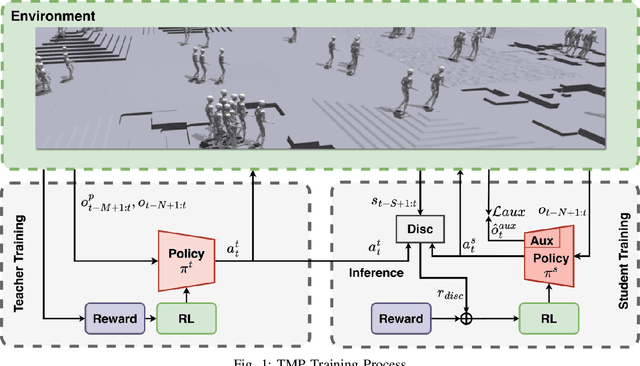
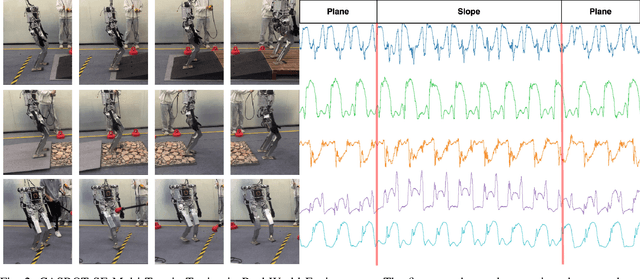
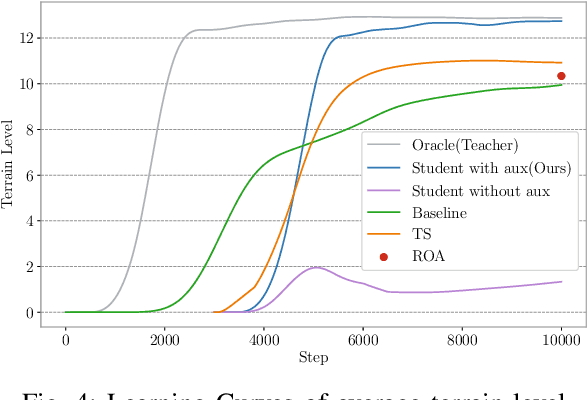
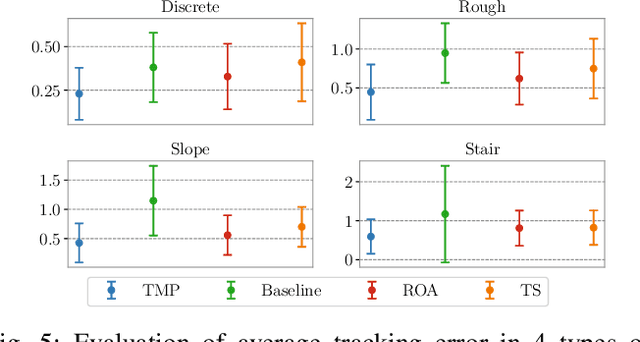
Abstract:Achieving robust locomotion on complex terrains remains a challenge due to high dimensional control and environmental uncertainties. This paper introduces a teacher prior framework based on the teacher student paradigm, integrating imitation and auxiliary task learning to improve learning efficiency and generalization. Unlike traditional paradigms that strongly rely on encoder-based state embeddings, our framework decouples the network design, simplifying the policy network and deployment. A high performance teacher policy is first trained using privileged information to acquire generalizable motion skills. The teacher's motion distribution is transferred to the student policy, which relies only on noisy proprioceptive data, via a generative adversarial mechanism to mitigate performance degradation caused by distributional shifts. Additionally, auxiliary task learning enhances the student policy's feature representation, speeding up convergence and improving adaptability to varying terrains. The framework is validated on a humanoid robot, showing a great improvement in locomotion stability on dynamic terrains and significant reductions in development costs. This work provides a practical solution for deploying robust locomotion strategies in humanoid robots.
Bayesian Prompt Flow Learning for Zero-Shot Anomaly Detection
Mar 13, 2025Abstract:Recently, vision-language models (e.g. CLIP) have demonstrated remarkable performance in zero-shot anomaly detection (ZSAD). By leveraging auxiliary data during training, these models can directly perform cross-category anomaly detection on target datasets, such as detecting defects on industrial product surfaces or identifying tumors in organ tissues. Existing approaches typically construct text prompts through either manual design or the optimization of learnable prompt vectors. However, these methods face several challenges: 1) handcrafted prompts require extensive expert knowledge and trial-and-error; 2) single-form learnable prompts struggle to capture complex anomaly semantics; and 3) an unconstrained prompt space limit generalization to unseen categories. To address these issues, we propose Bayesian Prompt Flow Learning (Bayes-PFL), which models the prompt space as a learnable probability distribution from a Bayesian perspective. Specifically, a prompt flow module is designed to learn both image-specific and image-agnostic distributions, which are jointly utilized to regularize the text prompt space and enhance the model's generalization on unseen categories. These learned distributions are then sampled to generate diverse text prompts, effectively covering the prompt space. Additionally, a residual cross-attention (RCA) module is introduced to better align dynamic text embeddings with fine-grained image features. Extensive experiments on 15 industrial and medical datasets demonstrate our method's superior performance.
Progressive Boundary Guided Anomaly Synthesis for Industrial Anomaly Detection
Dec 23, 2024Abstract:Unsupervised anomaly detection methods can identify surface defects in industrial images by leveraging only normal samples for training. Due to the risk of overfitting when learning from a single class, anomaly synthesis strategies are introduced to enhance detection capability by generating artificial anomalies. However, existing strategies heavily rely on anomalous textures from auxiliary datasets. Moreover, their limitations in the coverage and directionality of anomaly synthesis may result in a failure to capture useful information and lead to significant redundancy. To address these issues, we propose a novel Progressive Boundary-guided Anomaly Synthesis (PBAS) strategy, which can directionally synthesize crucial feature-level anomalies without auxiliary textures. It consists of three core components: Approximate Boundary Learning (ABL), Anomaly Feature Synthesis (AFS), and Refined Boundary Optimization (RBO). To make the distribution of normal samples more compact, ABL first learns an approximate decision boundary by center constraint, which improves the center initialization through feature alignment. AFS then directionally synthesizes anomalies with more flexible scales guided by the hypersphere distribution of normal features. Since the boundary is so loose that it may contain real anomalies, RBO refines the decision boundary through the binary classification of artificial anomalies and normal features. Experimental results show that our method achieves state-of-the-art performance and the fastest detection speed on three widely used industrial datasets, including MVTec AD, VisA, and MPDD. The code will be available at: https://github.com/cqylunlun/PBAS.
Few-shot Defect Image Generation based on Consistency Modeling
Aug 01, 2024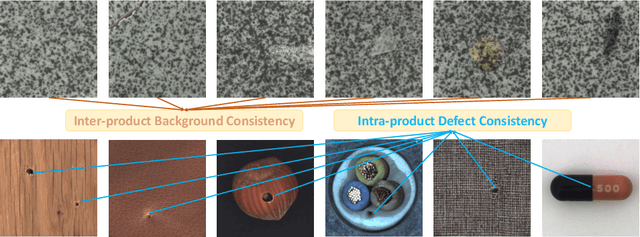
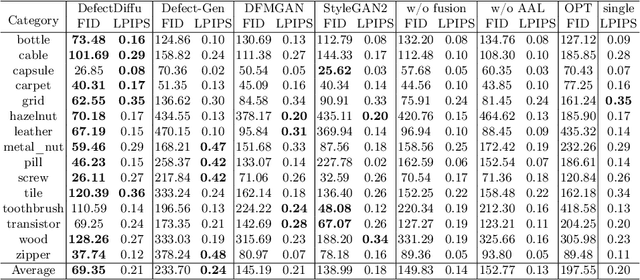
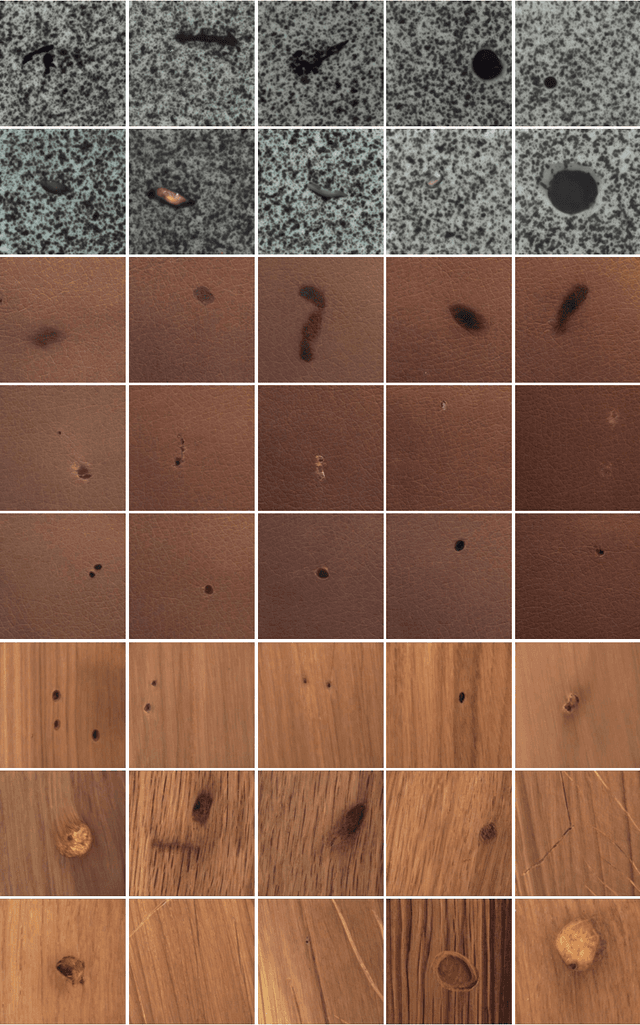
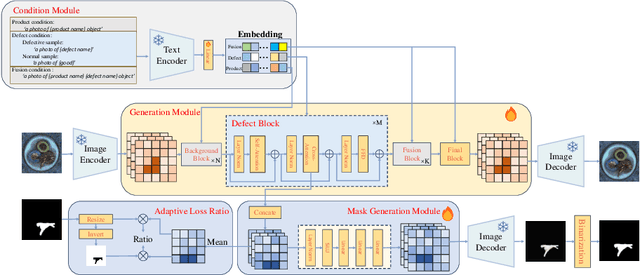
Abstract:Image generation can solve insufficient labeled data issues in defect detection. Most defect generation methods are only trained on a single product without considering the consistencies among multiple products, leading to poor quality and diversity of generated results. To address these issues, we propose DefectDiffu, a novel text-guided diffusion method to model both intra-product background consistency and inter-product defect consistency across multiple products and modulate the consistency perturbation directions to control product type and defect strength, achieving diversified defect image generation. Firstly, we leverage a text encoder to separately provide consistency prompts for background, defect, and fusion parts of the disentangled integrated architecture, thereby disentangling defects and normal backgrounds. Secondly, we propose the double-free strategy to generate defect images through two-stage perturbation of consistency direction, thereby controlling product type and defect strength by adjusting the perturbation scale. Besides, DefectDiffu can generate defect mask annotations utilizing cross-attention maps from the defect part. Finally, to improve the generation quality of small defects and masks, we propose the adaptive attention-enhance loss to increase the attention to defects. Experimental results demonstrate that DefectDiffu surpasses state-of-the-art methods in terms of generation quality and diversity, thus effectively improving downstream defection performance. Moreover, defect perturbation directions can be transferred among various products to achieve zero-shot defect generation, which is highly beneficial for addressing insufficient data issues. The code are available at https://github.com/FFDD-diffusion/DefectDiffu.
ALMRR: Anomaly Localization Mamba on Industrial Textured Surface with Feature Reconstruction and Refinement
Jul 25, 2024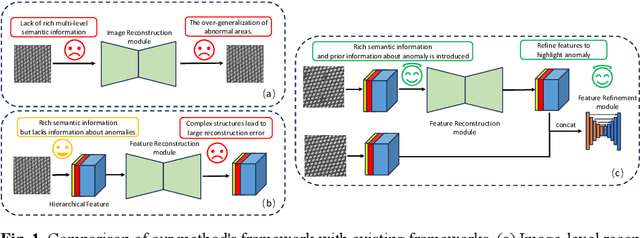

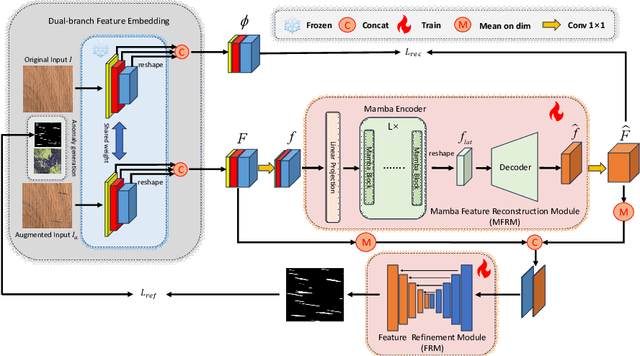

Abstract:Unsupervised anomaly localization on industrial textured images has achieved remarkable results through reconstruction-based methods, yet existing approaches based on image reconstruction and feature reconstruc-tion each have their own shortcomings. Firstly, image-based methods tend to reconstruct both normal and anomalous regions well, which lead to over-generalization. Feature-based methods contain a large amount of distin-guishable semantic information, however, its feature structure is redundant and lacks anomalous information, which leads to significant reconstruction errors. In this paper, we propose an Anomaly Localization method based on Mamba with Feature Reconstruction and Refinement(ALMRR) which re-constructs semantic features based on Mamba and then refines them through a feature refinement module. To equip the model with prior knowledge of anomalies, we enhance it by adding artificially simulated anomalies to the original images. Unlike image reconstruction or repair, the features of synthesized defects are repaired along with those of normal areas. Finally, the aligned features containing rich semantic information are fed in-to the refinement module to obtain the anomaly map. Extensive experiments have been conducted on the MVTec-AD-Textured dataset and other real-world industrial dataset, which has demonstrated superior performance com-pared to state-of-the-art (SOTA) methods.
VCP-CLIP: A visual context prompting model for zero-shot anomaly segmentation
Jul 17, 2024

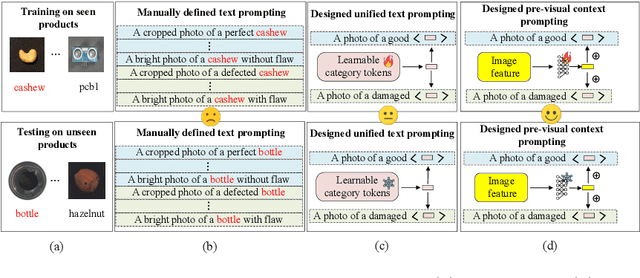

Abstract:Recently, large-scale vision-language models such as CLIP have demonstrated immense potential in zero-shot anomaly segmentation (ZSAS) task, utilizing a unified model to directly detect anomalies on any unseen product with painstakingly crafted text prompts. However, existing methods often assume that the product category to be inspected is known, thus setting product-specific text prompts, which is difficult to achieve in the data privacy scenarios. Moreover, even the same type of product exhibits significant differences due to specific components and variations in the production process, posing significant challenges to the design of text prompts. In this end, we propose a visual context prompting model (VCP-CLIP) for ZSAS task based on CLIP. The insight behind VCP-CLIP is to employ visual context prompting to activate CLIP's anomalous semantic perception ability. In specific, we first design a Pre-VCP module to embed global visual information into the text prompt, thus eliminating the necessity for product-specific prompts. Then, we propose a novel Post-VCP module, that adjusts the text embeddings utilizing the fine-grained features of the images. In extensive experiments conducted on 10 real-world industrial anomaly segmentation datasets, VCP-CLIP achieved state-of-the-art performance in ZSAS task. The code is available at https://github.com/xiaozhen228/VCP-CLIP.
A Unified Anomaly Synthesis Strategy with Gradient Ascent for Industrial Anomaly Detection and Localization
Jul 12, 2024



Abstract:Anomaly synthesis strategies can effectively enhance unsupervised anomaly detection. However, existing strategies have limitations in the coverage and controllability of anomaly synthesis, particularly for weak defects that are very similar to normal regions. In this paper, we propose Global and Local Anomaly co-Synthesis Strategy (GLASS), a novel unified framework designed to synthesize a broader coverage of anomalies under the manifold and hypersphere distribution constraints of Global Anomaly Synthesis (GAS) at the feature level and Local Anomaly Synthesis (LAS) at the image level. Our method synthesizes near-in-distribution anomalies in a controllable way using Gaussian noise guided by gradient ascent and truncated projection. GLASS achieves state-of-the-art results on the MVTec AD (detection AUROC of 99.9\%), VisA, and MPDD datasets and excels in weak defect detection. The effectiveness and efficiency have been further validated in industrial applications for woven fabric defect detection. The code and dataset are available at: \url{https://github.com/cqylunlun/GLASS}.
 Add to Chrome
Add to Chrome Add to Firefox
Add to Firefox Add to Edge
Add to Edge